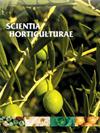Variations in the nutritional profile and colour parameters of sweet potato varieties with different flesh colours: Effects of cropping system, mulching and growing season
IF 3.9
2区 农林科学
Q1 HORTICULTURE
引用次数: 0
Abstract
The study investigated the effects of cropping system (CS), mulching (M) and year (Y) on the nutritional profile and colour parameters of four sweet potato varieties, namely Purple Speclet, Martina, Janja and Lučka. The results showed that the variations were mainly due to the genetic makeup of the varieties, with Purple Speclet having the highest dry matter, protein, vitamin C content, total phenolic content, antioxidant potential and total soluble solids. Lučka had the highest total sugar content, while Martina and Janja only stood out in terms of glucose content. The nutritional parameters correlated strongly with the colour parameters, suggesting that colour could be a useful indicator for predicting the nutritional quality of sweet potatoes. Nutritional parameters such as total phenolic content (TPC), vitamin C, antioxidant activity (AOP) and dry matter (DM) were significantly influenced by growing season, cropping system and mulching. The growing season had the greatest influence on TPC, vitamin C, AOP and DM. Mulching had the highest impact on DM, glucose content and vitamin C, while the cropping system had the highest impact on vitamin C, AOP and protein content. In particular, organic farming without PE mulching during the growing season resulted in higher levels of vitamin C, TPC and AOP, especially in relatively less favourable weather conditions. However, when PE mulch was used, there was a significant decrease in TPC and AOP. In contrast, no significant environmental influence was observed for the colour parameters, evidently differentiated in the purple-fleshed genotype with respect to the others, indicating that they are predominantly under strong genetic control. The results could help to introduce nutrient-rich sweet potato varieties into sustainable cropping systems and promote the production of sweet potatoes in Europe, particularly the Slovenian varieties Lučka, Martina and Janja, which have not been widely cultivated to date.不同肉色甘薯品种的营养成分和颜色参数的变化:耕作制度、地膜覆盖和生长季节的影响
该研究调查了耕作制度(CS)、地膜覆盖(M)和年份(Y)对四个甘薯品种(即 Purple Speclet、Martina、Janja 和 Lučka)的营养成分和颜色参数的影响。结果表明,这些变化主要是由品种的遗传构成造成的,其中 Purple Speclet 的干物质、蛋白质、维生素 C 含量、总酚含量、抗氧化潜力和总可溶性固形物含量最高。Lučka 的总糖含量最高,而 Martina 和 Janja 仅在葡萄糖含量方面表现突出。营养参数与颜色参数密切相关,这表明颜色可以作为预测红薯营养质量的有用指标。总酚含量(TPC)、维生素 C、抗氧化活性(AOP)和干物质(DM)等营养参数受生长季节、耕作制度和地膜覆盖的影响很大。生长季节对总酚含量、维生素 C、抗氧化活性和干物质的影响最大。地膜覆盖对 DM、葡萄糖含量和维生素 C 的影响最大,而耕作制度对维生素 C、AOP 和蛋白质含量的影响最大。尤其是在生长季节不使用聚乙烯地膜覆盖的有机耕作,维生素 C、TPC 和 AOP 含量更高,特别是在天气条件相对较差的情况下。然而,当使用聚乙烯覆盖物时,TPC 和 AOP 的含量显著下降。与此相反,在颜色参数方面没有观察到明显的环境影响,紫肉基因型与其他基因型明显不同,这表明它们主要受遗传的强烈控制。研究结果有助于将营养丰富的甘薯品种引入可持续种植系统,促进欧洲的甘薯生产,尤其是迄今尚未广泛种植的斯洛文尼亚品种 Lučka、Martina 和 Janja。
本文章由计算机程序翻译,如有差异,请以英文原文为准。
求助全文
约1分钟内获得全文
求助全文
来源期刊

Scientia Horticulturae
农林科学-园艺
CiteScore
8.60
自引率
4.70%
发文量
796
审稿时长
47 days
期刊介绍:
Scientia Horticulturae is an international journal publishing research related to horticultural crops. Articles in the journal deal with open or protected production of vegetables, fruits, edible fungi and ornamentals under temperate, subtropical and tropical conditions. Papers in related areas (biochemistry, micropropagation, soil science, plant breeding, plant physiology, phytopathology, etc.) are considered, if they contain information of direct significance to horticulture. Papers on the technical aspects of horticulture (engineering, crop processing, storage, transport etc.) are accepted for publication only if they relate directly to the living product. In the case of plantation crops, those yielding a product that may be used fresh (e.g. tropical vegetables, citrus, bananas, and other fruits) will be considered, while those papers describing the processing of the product (e.g. rubber, tobacco, and quinine) will not. The scope of the journal includes all horticultural crops but does not include speciality crops such as, medicinal crops or forestry crops, such as bamboo. Basic molecular studies without any direct application in horticulture will not be considered for this journal.
 求助内容:
求助内容: 应助结果提醒方式:
应助结果提醒方式:


